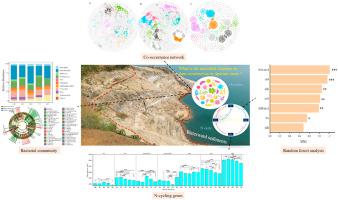Environmental Research ( IF 8.3 ) Pub Date : 2021-01-06 , DOI: 10.1016/j.envres.2021.110717 Huanjun Zhang , Liwei Sun , Yi Li , Wenlong Zhang , Lihua Niu , Longfei Wang

|
Dam construction has significantly altered riparian hydrological regime and environmental conditions in the reservoir region, yet knowledge concerning how bacterial community and N-cycling genes respond to these changes remains limited. In this study, we investigated the bacterial community composition, network structure and N-cycling genes in the water level fluctuation zones (WLFZs) of the Three Gorges Reservoir (TGR). Here, samples collected from five different water levels were divided into three groups: waterward sediments, interface sediments, and landward soils. Our results show that higher contents of NO2−-N, SOC, DOC, NH4+-N, and TP were characterized in waterward and interface sediments whereas higherNO3−-N content was observed in landward soils. The α-diversity of bacterial community decreased gradually from waterward sediments to landward soils. Compared with waterward sediments and landward soils, the interface sediments showed a unique bacterial community pattern with diverse primary producers as well as N-cycling microbes. The interface sediments also had a much more complex co-occurrence network and a higher possible community stability. Among all of N-cycling genes, higher abundances of nrfA and AOA amoA genes were observed in interface sediments. The dissimilarity in bacterial community composition and N-cycling gene abundance was mainly driven by water-level. Moreover, random forest model revealed that AOA amoA and nirS genes were the most sensitive indicators in response to water level fluctuations. Overall, this study suggests distinct abundance, diversity, and network structure of microbes in riparian sediments and soils across the gradient of water levels and enhances our understanding with respect to comprehensive effects of dam construction on nitrogen cycle.
中文翻译:

河岸带大坝建设对细菌群落结构和N循环基因丰度的响应
大坝的建设已大大改变了库区的河岸水文状况和环境条件,但有关细菌群落和N循环基因如何响应这些变化的知识仍然有限。在这项研究中,我们调查了三峡水库(TGR)水位波动区(WLFZs)中的细菌群落组成,网络结构和N循环基因。在这里,从五个不同水位收集的样本分为三类:水向沉积物,界面沉积物和陆向土壤。我们的研究结果表明,NO的含量较高2 - -N,SOC,DOC,NH 4 + -N,和TP进行了表征在waterward和接口沉积物而higherNO 3 -在陆上土壤中观察到-N含量。从水底沉积物到陆地土壤,细菌群落的α多样性逐渐降低。与水域沉积物和陆上土壤相比,界面沉积物显示出独特的细菌群落模式,具有不同的初级生产者以及氮循环微生物。界面沉积物还具有更复杂的共生网络和更高的群落稳定性。在所有的N-循环基因中,在界面沉积物中观察到了更高的nrfA和AOA amoA基因丰度。细菌群落组成和N-循环基因丰度的差异主要是由水位驱动的。此外,随机森林模型显示AOA amoA和nirS基因是响应水位波动的最敏感指标。总体而言,这项研究表明,在整个水位梯度上,河岸沉积物和土壤中微生物的丰度,多样性和网络结构具有明显的区别,并增强了我们对大坝建设对氮循环的综合影响的理解。


























 京公网安备 11010802027423号
京公网安备 11010802027423号